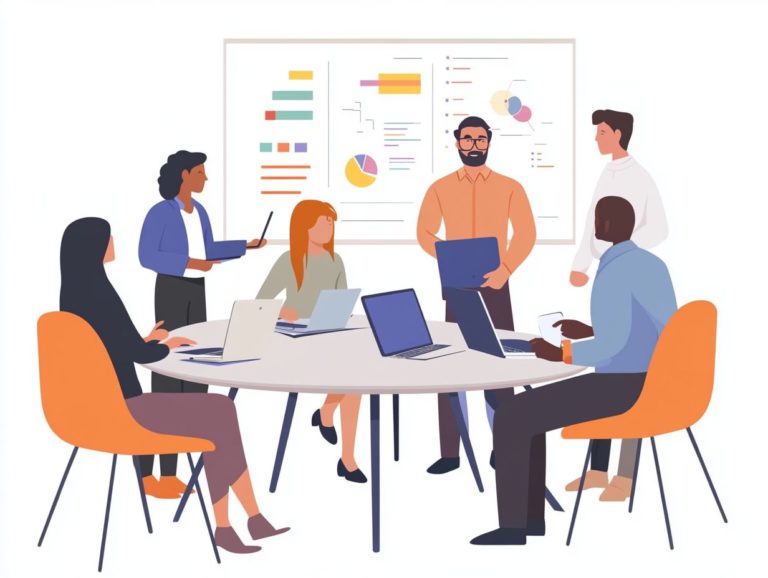The Best Practices for Skill Enhancement Programs
In today s fast-paced world, continuous learning has become indispensable for individuals and organizations striving to maintain a competitive edge.
Skill Enhancement Programs are pivotal in nurturing professional growth and adaptability. This article delves into the core elements of these programs, highlighting their significance, benefits, various types, and effective design strategies.
You will explore practical steps for implementation and methods for evaluating success. Learn how these programs can boost your career and drive your organization to new heights!
Contents
- Key Takeaways:
- Understanding Skill Enhancement Programs
- The Importance of Skill Enhancement
- Types of Skill Enhancement Programs
- Designing an Effective Skills Improvement Program
- Implementing a Skills Improvement Program
- Evaluating the Effectiveness of a Skills Improvement Program
- Frequently Asked Questions
- What are the best practices for skill enhancement programs?
- How do you identify the specific skills to focus on in a skill enhancement program?
- Why is it important to set clear goals and objectives for a skill enhancement program?
- What are some effective learning methods that can be used in skill enhancement programs?
- How can ongoing support and resources be provided in a skill enhancement program?
- Why is evaluating the effectiveness of a skill enhancement program important?
Key Takeaways:

- Continuous skill enhancement is crucial for personal and organizational growth.
- An effective skill enhancement program should be well-designed, implemented, and evaluated.
- Skill enhancement programs can take various forms, such as training, education, and development.
Understanding Skill Enhancement Programs
Skill enhancement programs are meticulously structured initiatives aimed at elevating employee capabilities and nurturing a culture of continuous learning and professional growth within organizations. To maximize this growth, consider exploring the best skill enhancement workshops to attend. These programs typically employ a variety of training methodologies, including mentorship, coaching, and new online learning tools, effectively bridging skill gaps and aligning workforce development with organizational objectives.
In an era marked by rapid digital transformation and shifting job requirements, leading organizations like LinkedIn Learning and Google highlight the critical importance of tailored training programs to foster employee engagement and retention. Understanding the fundamentals of these programs can profoundly influence overall business outcomes.
What are Skill Enhancement Programs?
Skill enhancement programs are designed with the express purpose of elevating your competencies to meet both current and future job demands.
These initiatives offer a diverse array of options, ranging from targeted training sessions honing in on specific job-related skills to personalized coaching opportunities that provide tailored guidance and feedback. Training can manifest in various formats, such as workshops, online courses, or on-the-job training, all customized to fit your individual needs as well as those of your organization.
A strong learning culture is essential, motivating you and your colleagues to pursue continuous development and engage in knowledge sharing, effectively bridging any skill gaps. By investing in these programs, organizations not only nurture your growth but also enhance overall productivity and employee satisfaction.
The Importance of Skill Enhancement
The significance of skill enhancement in today s swiftly changing work landscape is paramount. It not only fuels your professional growth but also enhances your job satisfaction, aligning seamlessly with the broader objectives of your organization.
Benefits for Individuals and Organizations
The benefits of skill enhancement programs are significant for both you and your organization, and understanding the challenges of skill enhancement can create an atmosphere of continuous learning and heightened employee engagement.
These programs are vital for advancing your career, offering invaluable opportunities for upskilling that can lead to promotions and greater job satisfaction. As you acquire new competencies, you become more adaptable, ready to tackle emerging challenges and harness new technologies.
On the organizational front, implementing these initiatives can dramatically improve performance metrics. A well-trained workforce is typically more efficient and productive. Investing in your development not only enhances your skill set but also builds loyalty, making it easier for your company to retain top talent and reduce turnover rates.
Types of Skill Enhancement Programs

You ll find a variety of skill enhancement programs available, such as:
- formal training initiatives – structured programs designed to build specific skills.
- mentorship opportunities – pairing employees with experienced mentors for guidance.
- digital learning solutions – online platforms providing flexible learning options.
All meticulously designed to cater to the unique development needs of employees.
Training, Education, and Development
Training, education, and development are essential elements of skill enhancement, enabling you to upskill and adapt to the ever-evolving demands of your industry.
These components work together harmoniously to create a comprehensive approach that equips you with the specific knowledge you need while nurturing a culture of continuous learning and adaptability. Training offers hands-on experiences and immediate skill acquisition. Education deepens your theoretical understanding, preparing you for more complex problem-solving scenarios. Development initiatives ensure that you not only retain what you learn but also apply it strategically in real-world contexts.
Regular skill assessments become vital in this journey, pinpointing gaps in knowledge and performance. This insight allows organizations to tailor development strategies that drive meaningful improvements, ultimately enhancing overall productivity.
Designing an Effective Skills Improvement Program
Crafting an effective skills improvement program calls for a careful plan that weaves together instructional design principles, personalized learning methods, and analytics tools. Incorporating the top 5 skill enhancement techniques for professionals allows you to customize training to meet the unique needs of each employee, ensuring that everyone gains the skills they require to excel.
Key Elements and Considerations
Key elements and considerations in designing your skills improvement program include understanding the learning needs of your team, determining the effectiveness of the training, and recognizing why skill enhancement should be a priority to ensure alignment with company performance goals.
Identify specific learning gaps through targeted assessments and feedback mechanisms. This ensures that your program addresses real-world challenges. For example, if your organization discovers that the team struggles with data analysis, you can develop a focused training module to bridge that gap. Setting clear performance metrics allows participants to measure their progress and reinforces accountability.
Successful programs often incorporate personalized learning methods, creating an environment conducive to continuous improvement. By integrating regular feedback from participants, you not only enhance engagement but also gain vital insights for necessary revisions, ensuring your program remains relevant and effective over time.
Implementing a Skills Improvement Program
Kickstart your skills improvement program with an engaging approach. Get employees involved and create a feedback culture that boosts performance levels. This method cultivates a culture of continuous improvement and ensures that everyone involved feels valued and heard.
Steps for Successful Implementation

The path to successfully implementing a skills improvement program begins with a thorough analysis of your workforce, defining clear objectives, and establishing coaching initiatives that promote ongoing development.
- Start by conducting a comprehensive assessment of your current workforce to pinpoint skills gaps and identify areas needing improvement. This deep dive will help you grasp the unique needs of your employees and the skills crucial for achieving your business goals.
- Next, it’s essential to set measurable objectives. These targets act as a roadmap for evaluating progress and ensuring alignment with your broader organizational aims.
- Integrating robust coaching programs into your initiative creates an environment of continuous learning. Such programs not only elevate employee capabilities but also play a vital role in boosting retention rates and overall engagement, as individuals feel valued and are empowered to lead in their professional journeys.
Evaluating the Effectiveness of a Skills Improvement Program
Evaluating the effectiveness of a skills improvement program is crucial for grasping its impact on performance metrics and ensuring the continuous improvement of your training initiatives.
By conducting this assessment, you gain valuable insights that can drive further enhancements and optimize outcomes, ultimately leading to greater success in your endeavors.
Take these steps today and watch your team thrive!
Measuring Impact and Making Improvements
Measuring the impact of skill enhancement programs requires you to check how well the training works and make necessary improvements based on ways to gather feedback and performance data.
To understand the implications, explore various qualitative and quantitative approaches. Quantitative methods could involve analyzing employee performance metrics, completion rates, and pre- and post-training assessments to objectively gauge progress.
Qualitative approaches might include conducting interviews or focus groups that delve into participants’ personal experiences and their perceived value of the training.
By intertwining these methods, you can establish feedback mechanisms that not only pinpoint areas for development but also align skill acquisition with overarching organizational objectives. Don’t miss the chance to align skill acquisition with your goals!
This alignment fosters a culture of continuous improvement and targeted skill growth within your organization.
Frequently Asked Questions
What are the best practices for skill enhancement programs?
The best practices for skill enhancement programs include:
- Identifying specific skills to focus on,
- Setting clear goals and objectives,
- Using a variety of learning methods,
- Providing ongoing support and resources, and
- Evaluating the effectiveness of the program.
How do you identify the specific skills to focus on in a skill enhancement program?

To identify the specific skills to focus on, it is important to conduct a needs assessment to determine the current skill levels and future skill needs of the participants. This can be done through surveys, interviews, and performance evaluations.
Why is it important to set clear goals and objectives for a skill enhancement program?
Setting clear goals and objectives helps provide direction and purpose for the program. This ensures that participants understand what is expected of them and what they can achieve through the program.
What are some effective learning methods that can be used in skill enhancement programs?
Effective learning methods in skill enhancement programs include hands-on training, interactive workshops, job shadowing, online courses, and mentorship programs. For more insights, explore the evolution of skill enhancement programs. Using a variety of methods caters to different learning styles.
How can ongoing support and resources be provided in a skill enhancement program?
Ongoing support and resources can be provided through regular check-ins, access to online learning platforms, and additional training or coaching as needed. It is important to create a supportive and encouraging learning environment.
Why is evaluating the effectiveness of a skill enhancement program important?
Evaluating the effectiveness of a skill enhancement program helps determine if the program has met its goals and if participants have gained the desired skills. This information can then be used to make improvements and adjustments for future programs.






